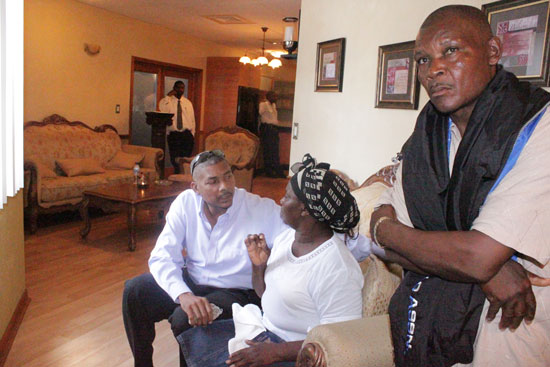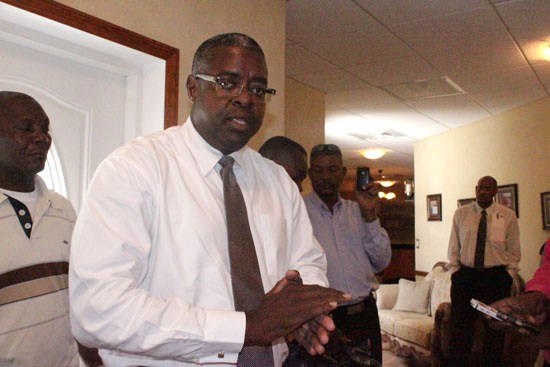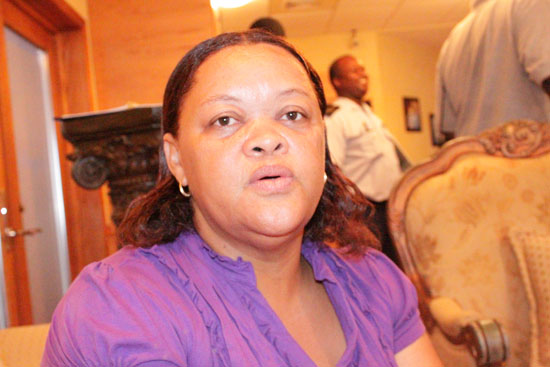 Sucker Garden:--- Relatives of murder victim Clemencia Josi-anne Julot created some confusion at the Royal Funeral Home on Monday when the body was prepared for the funeral. Family members accused the Royal Funeral Home of not putting the body on ice causing it to fully decompose. The family also alleged that authorities on the French side told them the young woman met her demise about three hours before the body was found. Reasons why they said they cannot understand how the body decayed.
Sucker Garden:--- Relatives of murder victim Clemencia Josi-anne Julot created some confusion at the Royal Funeral Home on Monday when the body was prepared for the funeral. Family members accused the Royal Funeral Home of not putting the body on ice causing it to fully decompose. The family also alleged that authorities on the French side told them the young woman met her demise about three hours before the body was found. Reasons why they said they cannot understand how the body decayed.Julot's mother Viergenie Julot said management of Royal promised her that they were going to dress the young woman in proper clothing but that was not done. Members of the media were called to the scene when the undertakers of Royal prevented a crowd of people that was gathered at the funeral home to view the body, all of which was done for their own health and hygiene safety.
Shortly after, several police officers and the detectives working on solving the gruesome murder showed up at Royal where they held a meeting with the immediate family, members of the Haitian Association and management of Royal Funeral Home to decide if they were going to go ahead and lay the body rest.
 Franklin Meyers director and CEO of Royal Funeral Home said Royal Funeral Home will not take any blame for the state of the body. Meyers said when the search team and family members found the slain victim the body was already in a state of decomposition. "The body was smelling and there were maggots all over the body. That alone is evidence that the body was decaying already and there is nothing Royal Funeral Home or any other Funeral Home could have done to reverse the decomposition." Meyers further explained that the police held the body for two weeks as they waited for the pathologist to come from Curacao to conduct the autopsy. The CEO further stated that on top of that the family held the body for another month because they wanted relatives from Haiti to come attend the funeral. Meyers said his staff assisted the family to the fullest extent and he as well as his attorney explained them that the body was not in proper condition to stay that long. As for viewing and dressing the body Meyers said he explained the family that a decomposed body cannot be dressed he said he told the family to bring whatever clothing and it will be placed on top of the body, which is what they did. He said even though the law states that decomposed bodies are to be buried immediately he allowed the immediate relatives to view the body on several occasions. " We agreed with the family that only two people were going to see the body on Monday which was her brother and cousin who came from Haiti for the funeral. But every one of them claimed they are her relatives and they all wanted to see the body and because they were refused they caused this confusion."Meyers said.
Franklin Meyers director and CEO of Royal Funeral Home said Royal Funeral Home will not take any blame for the state of the body. Meyers said when the search team and family members found the slain victim the body was already in a state of decomposition. "The body was smelling and there were maggots all over the body. That alone is evidence that the body was decaying already and there is nothing Royal Funeral Home or any other Funeral Home could have done to reverse the decomposition." Meyers further explained that the police held the body for two weeks as they waited for the pathologist to come from Curacao to conduct the autopsy. The CEO further stated that on top of that the family held the body for another month because they wanted relatives from Haiti to come attend the funeral. Meyers said his staff assisted the family to the fullest extent and he as well as his attorney explained them that the body was not in proper condition to stay that long. As for viewing and dressing the body Meyers said he explained the family that a decomposed body cannot be dressed he said he told the family to bring whatever clothing and it will be placed on top of the body, which is what they did. He said even though the law states that decomposed bodies are to be buried immediately he allowed the immediate relatives to view the body on several occasions. " We agreed with the family that only two people were going to see the body on Monday which was her brother and cousin who came from Haiti for the funeral. But every one of them claimed they are her relatives and they all wanted to see the body and because they were refused they caused this confusion."Meyers said.According to the law of the Netherlands Antilles the body should have been taken immediately after it was discovered to the cemetery for burial but since St. Maarten do not have a pathologist they were forced to wait on one to come and do the autopsy. "When a body is confiscated we cannot embalm the body, actually we are not allowed to touch or open that body bag. So there was nowhere we could have embalmed the body." Meyers said when a body is decomposed the veins collapse so embalming cannot be done. Furthermore he said funeral homes nowadays do not use ice. They either embalm a dead body soon after the person dies or they do it after the autopsy. Meyers said his staff placed the Julot's body in two body bags and then in a steel box called the ziggler to keep it that long.
 "They saw the body and they all know how she looked, they know that the body was decaying and for them to try and blame Royal is not fair", said an officer who saw the body when it was discovered in Oyster Pond on July 2. Clemencia Josi-Anne Julot went missing on June 29th and her body was recovered on July 2. Supporting the statements of Franklin Meyers is a close friend and relative of the deceased Marilene Lawrence who said she was surprised at the commotion and the delay the family caused on Monday. Lawrence said she knew the body was decaying when it was found because the detectives told it to her on the day the body was found. Lawrence said because of that the detectives and Royal did not allow her to see the corps on July 2. She further explained that she went to the scene where the body was found and she saw on the spot a lot of maggots even after the body was removed. Lawrence said she is the one who finally identified the body the following Monday and the detectives could not show her the entire body. "All I was able to see was the face and the only thing that I could have recognized Clemencia by was her nose. Her entire face was damaged like bruised or burnt. So for the family to blame Royal today is wrong. I know they have lost a loved one and they are grieving but doing this is not going to change anything."
"They saw the body and they all know how she looked, they know that the body was decaying and for them to try and blame Royal is not fair", said an officer who saw the body when it was discovered in Oyster Pond on July 2. Clemencia Josi-Anne Julot went missing on June 29th and her body was recovered on July 2. Supporting the statements of Franklin Meyers is a close friend and relative of the deceased Marilene Lawrence who said she was surprised at the commotion and the delay the family caused on Monday. Lawrence said she knew the body was decaying when it was found because the detectives told it to her on the day the body was found. Lawrence said because of that the detectives and Royal did not allow her to see the corps on July 2. She further explained that she went to the scene where the body was found and she saw on the spot a lot of maggots even after the body was removed. Lawrence said she is the one who finally identified the body the following Monday and the detectives could not show her the entire body. "All I was able to see was the face and the only thing that I could have recognized Clemencia by was her nose. Her entire face was damaged like bruised or burnt. So for the family to blame Royal today is wrong. I know they have lost a loved one and they are grieving but doing this is not going to change anything."After a lengthy discussion the body was taken to a church in Cole Bay for funeral services prior to the internment at the Cul de Sac cemetery.